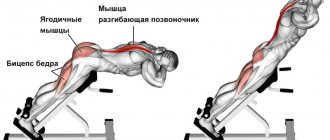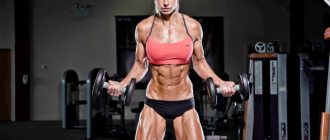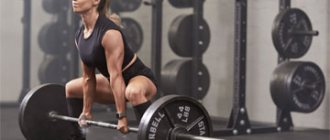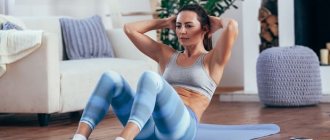Downward facing dog is one of the famous asanas in yoga. In Sanskrit its name sounds like “Adho Mukha Svanasana”.
The literal translation of the name of this asana: “adho mukha” - “face (muzzle) down”, “shvana” - “dog”. The asana is similar to the position of a dog with its front legs extended and stretched down.
This asana may seem quite simple at first glance, but this is not entirely true. To perform it correctly, you need to enter Downward-Facing Dog correctly and be sure to familiarize yourself with the contraindications.
If you practice hatha yoga in the hall, that is, under the guidance of a teacher, listen carefully to his instructions, but if you do it on your own at home, carefully study the description of the asanas and learn to listen to your body.
What does Downward Facing Dog asana mean in yoga?
The Sanskrit name for Downward-Facing Dog pose is Adho Mukha Svanasana. Adho mukha translates to "face down" and shvana means "dog". Hence the name. The pose really resembles a dog stretching relaxed and happy. This asana also looks like a triangle. You will need to imagine that you have formed a mountain with two smooth slopes and the top at the tailbone. This comparison will help you!
As we have already said, Adho Mukha Svanasana is one of the most relevant poses. It is repeated several times in each class and is part of the popular set of Surya Namaskar exercises. Beginners will need time and patience to master Downward-Facing Dog. But advanced yogis do it automatically; moreover, they are able to rest in this pose. Hard to believe? But this is true. And over time, you will also begin to be able to relax in it, the main thing is to master the correct technique.
Advantages
The benefits of this exercise are tangible:
- strengthens leg and back muscles
- makes calves toned
- shoulders strong
- stimulates blood circulation in the shoulder blade area
- improves breathing
Although this asana seems relatively easy, it requires a lot of activity, which may be a contraindication for some diseases of the joints, back or injuries. It energizes the body and mind, especially if it is included in the “sun salutation” part of the asana. Those who are just beginning to understand the basics and technique of this exercise can feel improved breathing with regular practice.
Benefits of exercise
- It, like any inverted asana (where the pelvis is higher than the head), gives a flow of fresh blood to the head. This is very important and useful: brain cells are renewed, complexion improves. In ordinary life, we do not take this position (washing floors, if only), so try to include this asana in your classes.
- One of the few asanas that stretches the back of the legs well (which we also don’t do in everyday life). It does this gently and painlessly, the main thing is not to pull anything with great effort. Be patient with your body. Do this exercise gradually, increasing the stretch over and over again.
- Lengthens the spine. Have you heard the expression “Children grow up, but old people grow down”? And this is true: over the years, a person’s spine settles, becomes less flexible, clamps appear, and vital energy can no longer flow freely along the spinal column. And the “Downward Facing Dog” pose very well stretches the spine, returning youth and strength to it.
- It opens up the chest, which is very important for “office people.” Notice how you sit? Are you slouching? Is your chest tight? But this shouldn’t happen. Constantly performing this asana removes these tensions, straightens the back and the space between the shoulder blades!
- Removes clamps in the cervical region, which is also very important. If the pose is performed incorrectly, on the contrary, these clamps will only intensify. Pay special attention to this!
show more
What else is so good about the Downward Facing Dog pose:
- Reduces pain in the lower back, neck (why this happens, it has already become clear to you)
- Stretches muscles, legs, arms and back
- Makes your hands strong
- Improves lung function, relevant for asthma - Massages internal organs
- Improves digestion
- Normalizes sleep and mild depression
Advanced Practice
To increase the stretch in the back of your legs, lift yourself up slightly onto the balls of your feet, pulling your heels up a couple of inches off the floor. Actively pull the entire inner leg area deep inward, starting from the hips and groin, ending with the inner side.
Finally, starting at the top of your thighs, lengthen the outside of your legs and lower your heels back toward the floor, bringing the outside of your heels into position first rather than the inside of your heels.
Turn your shoulders further and try to lower your head to the floor.
How to do Downward Facing Dog pose correctly
Now we will tell you how to perform this asana correctly, as well as the most common mistakes that beginners can make.
So, the execution technique:
ATTENTION! Descriptions of the exercises are given for a healthy person. It is better to start classes with an instructor. If you do it yourself, watch our video tutorial carefully! Wrong practice can be useless and even dangerous for the body.
Photo: yoga_caliber, victori_kim, oum.ru_saratov, wish.dreams.life
Variations
- Light version
A. if you experience discomfort and difficulty opening your shoulders in this pose, use a couple of blocks/bricks as support under your arms;
B. If you cannot place your heels on the floor, stand against a wall, lift your heels slightly and press them into the wall, keeping your toes and soles of your feet on the floor so as to lengthen the arch of your feet.
- Complicated version
Inhale and lift your leg so that the line of your leg and body are in the same plane; hold your leg for 30 seconds. While in this variation of the pose, fix your hips, do not turn your pelvis, to do this, actively stretch your heel in the direction opposite to the body. Exhale, lower your leg and repeat the variation on the other side.
Detailed technique for performing “Downward Facing Dog”
Step 1
First, let's look at how much distance should be between your feet and your palms. To do this, lower your knees to the floor, buttocks on your heels and stretch your arms forward. We direct our gaze between the palms.
Step 2
Palms are shoulder-width apart, fingers forward, knees and feet are also shoulder-width apart, hips and arms are perpendicular to the floor.
ATTENTION! Immediately press your palms to the floor! We feel that the entire palm is pressed, especially the pads under the index fingers.
Step 3
We rise up and shift our body weight forward, pointing our toes. We inhale and, as we exhale, push off with our hands, stretching back behind our pelvis.
Step 4
We begin to lift our knees off the floor and lift our pelvis up until you feel that your back has become straight and long.
Step 5
If you feel like you can raise your heels even higher, do so and straighten your knees even more. Try to push your hands harder from the floor and stretch your pelvis back and up.
Step 6
Lock yourself in this position. And when you feel ready, lower your heels to the floor.
ATTENTION! If your heels don't sink in, that's okay. So you leave them slightly raised. We assure you, at some point your practice will deepen and your heels will calmly drop.
Step 7
Take a few breaths! The chest reaches towards the hips, the lower back bends down, the tailbone reaches towards the sky. The abdomen is elongated and free.
ATTENTION! The gaze is directed downwards. Do not raise your head - otherwise your neck will become tense and blood flow to your head will be disrupted.
ATTENTION! Make sure you are not pinching your neck with your shoulders! To do this, you can roll forward slightly, pull your shoulders back, point your armpits towards your ears and push yourself back again with your arms.
Step 8
And when you finish performing this asana, shift your body weight forward, kneel down on the floor, buttocks resting on your heels. In this position (child's pose) we rest for a few seconds.
Time to perform the asana: start with 1 minute, bringing the exercise to 2-3 minutes.
Exit from the pose
As you inhale, bend your knees and lower them to the floor; to relax, move into Balasana (child's pose).
If you are performing Adho Mukha Svanasana as part of the traditional Sun Salutation sequence, then while inhaling, step or jump towards your hands, palms fixed in the same position - pressed to the floor. Bend your knees slightly if necessary. As you inhale, bend in the chest area and lift your head up. As you exhale, fold into Uttanasana. Next, pull yourself up with your arms into Tadasana (Mountain Pose).
Preparation for asana
It is unacceptable to start yoga classes by immediately getting into the downward-facing dog pose. The body must be prepared for it. To do this, perform a series of aerobic exercises. They allow you to warm up your muscles, increase blood flow, and activate all cells of the body. Active walking, running in a circle or in place, jumping, and rotating the limbs in the joints are suitable for this purpose.
The next stage of the warm-up is muscle stretching. To do this, you can take the “child’s pose” (“balasana”). With its help, the muscles of the back, legs and arms are prepared for work, and pressure is relieved from the intervertebral discs. Features of execution:
- The person kneels, pressing his pelvis to his heels. The legs are connected together.
- As you exhale, bend forward.
- Hands are located along the body and shins.
- Remain in this position for several minutes.
If your head cannot touch the floor, you can place a cushion or pillow under it. Child's pose can be used to begin and end the downward-facing dog asana.
Advice! To prevent your hands and feet from slipping when performing poses, you can use gloves or special yoga socks. They enhance grip on the floor and on the mat, and also absorb sweat.
Impact on men 3
Sadati further emphasizes that yoga will also be beneficial for men. Despite the fact that the stronger sex does not need special relaxation during sex, still performing asanas allows its representatives to get more pleasure from intimacy.
One study found that yoga helps combat premature ejaculation. 68 men with premature ejaculation took part in it. The study compared men who took conventional drug therapy (using Prozac) with those who instead regularly practiced yoga.
Statistically significant improvements in sexual performance were observed in both groups. The researchers concluded that "yoga may be one of the safe and effective non-pharmacological treatments for premature ejaculation."
Common mistakes
- Mistake: Throwing back the head.
Do not direct your gaze between your palms - this will lead to overstrain of the neck muscles and compression of the cervical arteries.
- Error: Position of fingers “house”
To keep your wrists safe, you need to ensure that your weight is evenly distributed across your palm. Do not bend your fingers, but rather straighten them and spread them apart. Press the bone under the third phalanx of your index finger and under the third phalanx of your little finger to the floor. Press the inner and outer parts of the heel of your hand at the wrist into the floor with equal force.
- Error: Overextension of the elbow joint.
To ensure the safety of your elbow joints, make sure that their extension angle does not exceed 180 degrees. This means keeping your elbows slightly soft at all times. In this case, you need to pull the biceps of the shoulder up: from the elbow to the shoulder.
- Error: Sagging of the chest downwards.
Don't try to pull your chest towards the floor. Your goal is to create a straight line of the spine from the tailbone to the crown. To do this, open your chest and at the same time direct your front lower ribs inward.
- Error: Rounding the back, twisting the tailbone down.
Try to reach your tailbone and sit bones up towards the ceiling.
- Error: Overextension of the knee joint.
To avoid hamstring strains and joint injuries, you need to be careful that you don't "switch off" your knee. Try to pull your kneecap up using your quadriceps femoris muscle.
- Mistake: Putting weight on the inside of the foot.
Try to raise the inner arch of your feet. Press the base of your feet firmly into the floor under your big toes and little toes, as well as the inside and outside of your heel. Spread your toes out to the sides.
Contraindications for performing asana
Before you begin to perform the “downward-facing dog” asana, you need to familiarize yourself with the contraindications. These include:
- Dyspnea.
- Carpal tunnel syndrome.
- Hypertension.
- Diseases of the cardiovascular system.
- Exacerbation of any pathologies of the spine.
- History of epilepsy.
- Glaucoma, cataracts or other visual impairment.
- Inflammation of the paranasal sinuses.
- Otitis.
- Bronchial asthma.
- Runny nose.
- Menstrual bleeding.
There are many contraindications to performing the downward-facing dog pose. If you have at least one disease from the list above, you should consult a specialist before starting classes.
Possible harm
Performing the downward-facing dog pose can be harmful to the health of a person who has previously suffered a traumatic brain injury. During the rehabilitation period it is strictly contraindicated. It should not be practiced by people with arthritis and arthrosis of the wrist joints.
All inverted poses should be performed with caution by people who have had a history of stroke. In general, an asana can cause harm only if it is performed incorrectly, or if all contraindications are ignored.
Downward-facing dog during pregnancy
The asana can be performed in the early stages of pregnancy. When the gestational period exceeds 28 weeks, it is recommended to discontinue the exercise. Yoga masters recommend that women in position place their legs wider than their shoulders, and rest their hands not on the floor, but on a chair. You should not pull the pelvis high so that the uterus does not put too much pressure on the lungs.
The exercise is abandoned if the woman feels dizzy or has any discomfort. You need to get out of the pose smoothly, without making sudden movements. An absolute ban on the asana is vasomotor rhinitis during pregnancy.
Tuning
After you enter the pose, observe your body and check that the alignment is correct. Please note the following points:
- Palms parallel to each other;
- Left hand and left leg, right hand and right legs - on the same line;
- The arms are an extension of the back, the shoulders turn outward;
- The fingers are spread out;
- The weight is evenly distributed between the arms and legs, thanks to the extension of the tailbone up. Don't keep the entire pose on your palms alone;
- The tailbone stretches upward;
- Feet stretch to the floor;
- Shoulders away from ears;
- The abdominal muscles are retracted;
- The lower back maintains a natural arch.
- The head is an extension of the back; do not lift it to avoid injury.
Research results2
One small study involved 40 healthy women. The participants spent 1 hour a day doing yoga every day. They performed poses aimed at improving the tone of the pelvic muscles and improving mood. Participants completed a questionnaire answering questions about their sex lives at the beginning and end of the study.
At the end of the experiment, average scores on the scales “sexual desire,” “arousal,” “lubrication,” “achieving orgasm,” and “overall satisfaction” increased. At the same time, two-thirds of women said that after the classes their sex life improved significantly. The best scores on the arousal and lubrication scales were found in women over 45 years of age.
Any style will do 7
Researchers believe that almost any type of yoga is suitable for these purposes - from Hatha or Ashtanga to ordinary restorative exercises. You can exercise in a specialized center, sports complex, or through video lessons.
Women should pay special attention to yoga classes. During pregnancy, menstruation or menopause, exercise may be limited and it is worth talking to your doctor about this. In general, yoga allows the fair sex to stabilize their mental state and harmonize relationships with their partners. The classes will be especially useful for those women who suffer from increased emotionality. It allows them to find peace and relieve stress.











